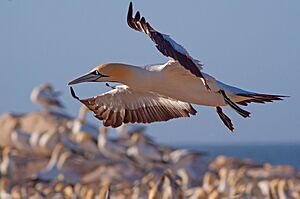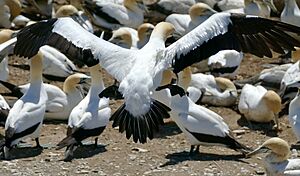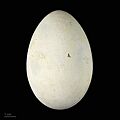Cape gannet facts for kids
Quick facts for kids Cape gannet |
|
|---|---|
 |
|
| Cape gannet, Bird Island, Lamberts Bay, South Africa | |
 |
|
| Cape gannet in flight | |
| Conservation status | |
| Scientific classification | |
| Genus: |
Morus (bird)
|
| Species: |
capensis
|
| Synonyms | |
|
Sula capensis |
|
The Cape gannet (Morus capensis) is a large seabird that belongs to the gannet family, Sulidae.
These birds are easy to spot because they are big. They have black and white feathers and a bright yellow head and back of the neck. Their pale blue beak is pointed and has small jagged edges near the tip. Because gannets dive very fast when they hunt fish (between 40 and 120 kilometers per hour), their beak does not have outside nostrils. This helps stop water from being forced in during their dives.
Contents
What is a Cape Gannet?
When you see a Cape gannet flying, its snow-white body, black tail, and dark wing tips make it easy to identify. If you get closer, you can see its special golden head and neck, which slowly turn white on its main neck. Young gannets are dark brown with a pale beak. They might look a bit like dark-colored boobies at first glance.
Adult Cape gannets are about 84 to 94 centimeters long. Their wings can spread out to about 171 to 185 centimeters. They usually weigh around 2.6 kilograms.
The Cape gannet looks a lot like the Australasian gannet and the northern gannet. However, the Cape gannet has an all-black tail. It also has a longer black stripe under its beak and more black on its face. These small differences are hard to see unless you are very close. The northern gannet has an all-white tail and only black tips on its wings.
Where Do Cape Gannets Live?
The Cape gannet breeds only in southern Africa. They live on three islands near Namibia and three islands near South Africa. They usually build their nests in big, crowded groups on flat islands. They also nest on flat ledges of steep islands, like Mercury Island off Namibia.
In 1996, scientists thought there were about 340,000 Cape gannets in the world. About 12% lived in Namibia and 88% in South Africa. The biggest group of these birds, with over 140,000 birds, is on Malgas Island in South Africa. Sometimes, a few Cape gannets have been seen breeding on islands off Australia with Australasian gannets.
When they are not breeding, Cape gannets can be found along the coast from the Gulf of Guinea in western Africa all the way to Mozambique on the east coast. They usually stay within 100 kilometers of the shore. However, some have been seen more than 200 kilometers out in the Atlantic Ocean and Indian Ocean.
Are Cape Gannet Numbers Changing?
The number of Cape gannets on the Namibian islands has gone down a lot. Between 1956 and 2000, the number of breeding pairs dropped from 114,600 to 18,200. This is an 84% decrease in less than 50 years.
However, on the South African islands, the numbers have gone up. In the same time period, the number of breeding pairs increased about 4.3 times, from 34,400 to 148,000.
Reproduction and Life Cycle
Gannet pairs often stay together for many breeding seasons. They have special greeting rituals at their nests. They stretch their beaks and necks up to the sky and gently tap their beaks together.
Cape gannets start breeding in August or September. They usually lay one bluish egg, which often gets dirty quickly. Both parents help to incubate the egg. Incubation lasts for 42 to 46 days until the egg hatches. Gannets use the webs on their feet to keep the egg warm. These foot webs have many blood vessels and are wrapped around the egg.
When a chick hatches, it is black, naked, and cannot see. It weighs only about 70 grams. But in just three weeks, its body weight is one-third of an adult's. By eight weeks, the chick weighs more than an adult. It stays this heavy until it is ready to fly, which happens when it is 95 to 105 days old.
How Cape Gannets Find Food
Cape gannets are strong fliers. They mostly use a "flap-gliding" method, which means they flap their wings and then glide. This uses more energy than the way albatrosses fly. Like all birds in the Sulidae family, Cape gannets eat fish. They hunt by diving headfirst into the water from high up in the air.
Images for kids







